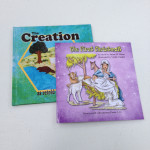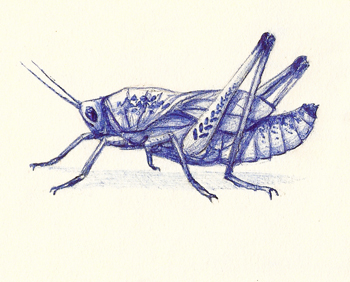Leviticus 11:20-23 Insects that walk on four legs?
I would like to attempt to shed some light on a passage of scripture that gives many people an excuse to discount the accuracy of the Bible. I am not concerning myself with whether or not we should eat these insects. Rather, I am taking issue with the words “insects that walk on all fours.”
20 All flying insects that walk on all fours are to be detestable to you. 21 There are, however, some winged creatures that walk on all fours that you may eat: those that have jointed legs for hopping on the ground. 22 Of these you may eat any kind of locust, katydid, cricket or grasshopper. 23 But all other winged creatures that have four legs you are to detest.
Use this link to read Leviticus 11:21-25 in more than one translation. There are Bible scoffers who are quick to point out verses 21 and 23 as proof that the Bible contains errors and should not be taken seriously. Here is one example of such an article.
Today’s elementary children are taught that insects have six legs, and rightly so. This is how insects have been classified by scientists around the world. Yet Leviticus 11:21 refers to insects such as grasshoppers, crickets, locusts, and katydids as insects that walk on four legs.
When Moses wrote the first five books of the Old Testament (including Leviticus) he didn’t first graduate from one of our schools to learn the word “insect.” He spoke ancient Hebrew. In his language there was a word that meant “fly” (עוף ooph). The following quote comes from the website “Ancient Hebrew Research Center.
Fly (עוף ooph, Strong’s #5774): This verb means ‘to fly’ while the noun form, pronounced oph [str:5775] but spelled the same, is a ‘flyer’ and can be a bird, bat or insect, anything that flies. Hebrew commonly uses word puns, words of similar sounds together. Genesis 1:20 is a good example where it says ve’oph ye’oph which means “flyers flying.”
So when we read the word “insect” in the Bible, we must understand that Moses never intended to be this specific in his word choices. Bible translators have made their best effort to put the Hebrew words of these ancient people into our language, and when it appeared that they were talking about insects, they used the English word insect.
The specific insects spoken of in Leviticus 11:21-22 were identified by our translators as grasshoppers, crickets, locusts, and katydids. If you watch these insects move around you will notice that when they are walking they use their front four legs to get them where they want to go while the back legs must simply follow or drag along. But if they need to hop, they use their over-sized back legs. The writer of Leviticus was simply using the language of his day to describe the difference between these flying creatures and other insects, birds, and bats.
Verse 23 speaks of other flying “insects” that have four legs, but the original text likely only meant flying creatures, not “insects.” This verse could easily have referred to bats, which sound pretty detestable as a food to me.
God gave us his living Word to teach us to love him and to love one another. His Word is also a record of how people have rejected him, yet he continually found ways to restore people to himself – eventually through the sacrifice of his only begotten Son, Jesus Christ. But people continue to turn away from him. They continue to read his Word looking only for their perceived “loopholes” rather than for seeking to know God.
God promises in his word that if we look for him we will find him if we will seek him with all our hearts. See Jeremiah 29:13.
Here is another interesting article about “Animals in the Bible.”
Scripture quoted by permission. Quotations designated (NIV) are from THE HOLY BIBLE: NEW INTERNATIONAL VERSION. Copyright 1973, 1978, 1984 by International Bible Society. Used by permission of Zondervan Publishing House. All rights reserved.
Post written by Janice D. Green, author of The First Christmas and The Creation.


Love this! I’m continually amazed at the lengths to which people will go to attempt to discredit the Bible without actually researching what they’re discrediting.
For your apologetics you shouldn’t just make up “facts”. Try observing actual grasshopper like things (or watch them on YouTube). They very often walk moving (not dragging) their hind legs.
But your whole argument (about grasshopper locomotion) is irrelevant. Leviticus is talking about all bug-like things (arthropods) and says they all have 4 legs (and seems unaware than some don’t fly). It also says that they are an abomination (שֶׁקֶץ), and people who contact them will become unclean and need to wash their clothes.
My guess is that the ancient Jews had a bug taboo and avoided them and wouldn’t think of picking one up and counting its legs.
This taboo caused ignorance about bug legs which is directly displayed in the parts of Leviticus proclaiming them abominable.
Who is making up facts? Perhaps “dragging” was a poor choice of words, but the hind legs are definitely not used in the same way as the other four which do the work of creeping as opposed to jumping. I have watched many grasshoppers and know the way the back legs are carried along rather lamely while walking. They are not weight bearing legs except when they are jumping. Furthermore, this was brought to my attention in a science class.
I also beg you to re-read the passage. It would be nice if we could read and understand it in the original language without using the translations we have available. I don’t see anything that says they “all” have four legs as many biased scientist prefer to believe. Moses is simply using the terminology of his day to describe specific flying creatures in order to distinguish them from the rest. Moses might not have been taught to classify six-legged creatures as insects, but he knew how to describe the flying creatures he was writing about.
As far as having a bug taboo, Moses was separating the ones that were OK to eat from the ones that were not OK to eat. Again, you should re-read the passage.